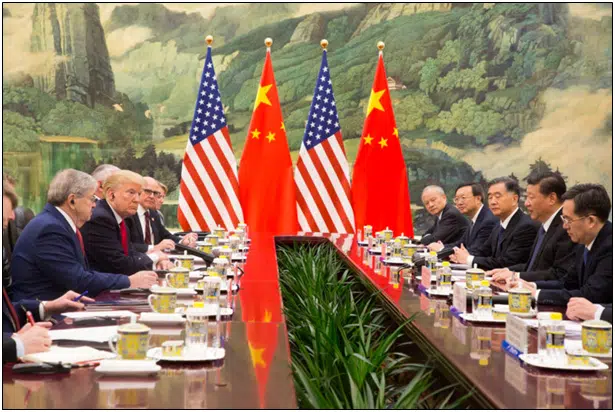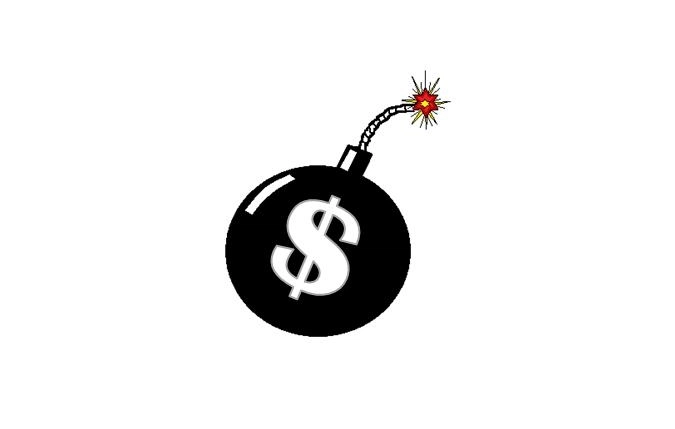Are we under economic attack? The author of a controversial 2009 Pentagon-contracted report, Kevin D. Freeman, seems to think so. Penned for the Department’s Irregular Warfare Support Program (IWSP), “Economic Warfare: Risks and Responses” outlines a “potential direct economic attack on the U.S. Treasury and U.S. dollar” intended to bankrupt the nation and destroy our currency.
The basic threat is a “focused effort to collapse the dollar by dumping Treasury bonds [which] has grave implications including the possibility of a downgrading of U.S. debt forcing rapidly rising interest rates and a collapse of the American economy.” Currently, foreign creditors hold $4.3 trillion of the $14.1 trillion national debt.
The report summarizes, “In short, a bear raid against the U.S. financial system remains possible and may even be likely.” But how would that be possible? How could the U.S. be so vulnerable to an attack against the nation’s key financial and governmental institutions?
The report suggests that government bailouts in 2008 to prop up the financial system has “saddled the U.S. Treasury with substantial debt.” This gives the nation’s creditors not only leverage over the government, but the means to pull the rug out from under it.
Since September 2008, the national debt has risen from $10 trillion to $14.1 trillion, close to 100 percent of the economy now. At exactly the same time of a sharp increase in borrowing, market demand for treasuries has apparently dropped, necessitating the Federal Reserve to intervene to purchase U.S. debt.
Pimco reports that in 2009, 80 percent of treasuries were purchased by the Fed, and in 2010, it had to buy 70 percent. This means about three-quarters of new government debt, brought about by Congress’ spending spree since the financial crisis began, is being financed by a printing press.
If that is because demand for treasuries has dropped markedly, that could mean Phase Three of the tri-pronged attack, outlined by Freeman, when treasuries are dumped may already be underway.
Sadly, printing money to pay off the debt is nothing new. It’s been tried countless times in history, and it has always resulted in the decline of entire societies. The nation’s exposure to such a systemic financial risk, whereby creditors can dump U.S. treasuries and bankrupt the nation, is largely because of the Fed’s printing press that helps the government to spend so much.

This chart, published in USA, Inc., pretty much says it all, outlining government spending as a share of the Gross Domestic Product (GDP). So does Mish’s Global Economic Trend Analysis, commenting on the chart, saying, “Note this mess started with the creation of the Fed.”
Basically, from 1790 to 1930, government spending as a percent of GDP averaged just 3 percent, with brief blips in the 1830’s and 1860’s. Until 1913, when the Federal Reserve was created to administer the nation’s supply of dollars.
Since then, government spending has gone through the roof. First, it skyrocketed in World War I, when it rose above 20 percent for the first time, and then again in 1930’s and 1940’s when it topped 40 percent. Since World War II, government spending has risen from a low of less than 15 percent to over 24 percent today.
So, what changed? How could an historic average of 3 percent government spending that prevailed for over a century rise so significantly? Because after 1913, the Fed could essentially print money to lend to the federal government. Judging by the skyrocketing of federal spending coupled with the advent of the Fed, the correlation is too strong to ignore.
Sadly, the USA, Inc. chart shows graphically when financial interests took control of the Republic. Once the government could lend itself money with fiat dollars, and financial institutions could reap the rewards by collecting interest payments on that debt, there was a perverse incentive to perpetually expand government spending and debt.
The politicians added to their own powers by expanding government’s reach, and the financial interests profited from it along the way.
No further explanation is really required as to why the national debt has increased every single year since 1958. It is why spending has nominally increased every year since 1965. Until today, the Fed is the number lender in the world to the government with over $1.23 trillion of U.S. treasuries, more than any foreign creditor including China or Japan.
Excessive government spending and corporate welfare has in turn corrupted our political system. Perhaps that is why Freeman warns that there are “legitimate questions about the performance of the regulatory regime [in Washington] and Wall Street institutions. Implications that these parties have been complicit or otherwise co-opted cannot be ruled out.”
You read that right. The report suggests there is a possibility that members in the highest positions of power in the U.S. government and financial institutions have been compromised by foreign enemies devoted to a single goal, the bankruptcy of the nation.
So, Freeman proposes that a study of this danger “be conducted outside of traditional Washington and Wall Street circles.” He recommends the creation of “a specialized threat finance unit to develop and implement appropriate countermeasures to emerging threats in coordination with key defense, intelligence, and financial agencies, preparing targeted global responses as needed.”
If true, Freeman’s contentious charges raise truly troubling questions about the state of representative government in the United States. It would mean that everything is at risk including preservation of the Constitution and the very liberty of the people.
And it has not gone unnoticed at the Department of Defense itself, which paid for the report and is patriotically trying to alert the American people to the danger. The national debt is considered to be the single biggest threat to national security by Admiral Mike Mullen, chairman of the Joint Chiefs of Staff.
And it can no longer be ignored by members of Congress, who need to immediately cut spending dramatically and pay down the debt — before time runs out.
Robert Romano is the Senior Editor of Americans for Limited Government.










